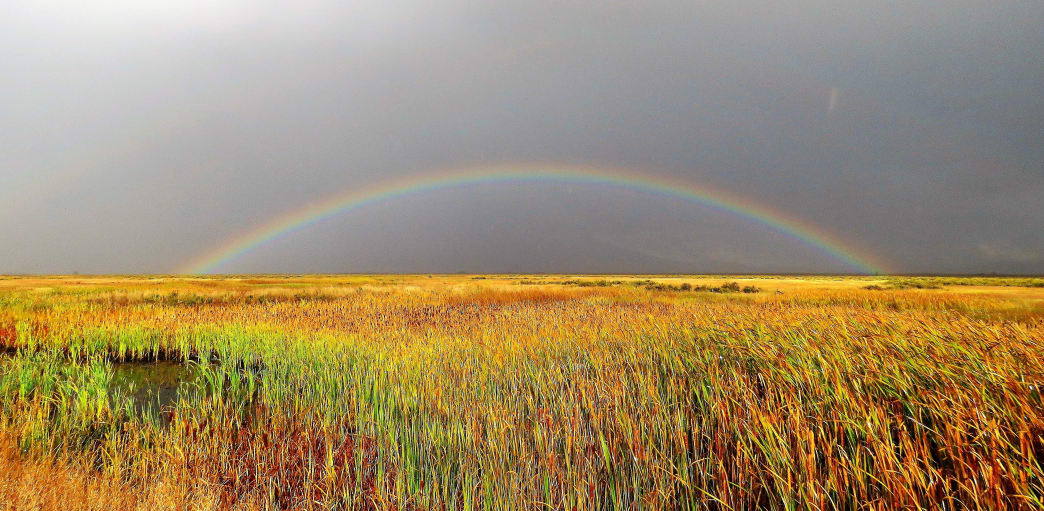Reaching a height of 750 feet, the sand dunes in Colorado’s San Luis Valley are the largest dunes in North America, and they attract thousands of travelers each year. But, something equally impressive lies beyond these mountains of sand. Looking like massive shark teeth, a collection of ten 14,000-foot peaks pierce the sky and tower over the valley. These mountains in the Sangre de Cristo Range not only provide a dramatic backdrop to Great Sand Dunes National Park and Preserve, but they also offer the chance to experience amazing hikes and other adventures beyond the park’s boundaries.
Outside of the park, you’ll not only encounter rugged mountains, but also several other ecosystems, including wetlands, grasslands, and the Riparian area where cottonwoods, aspens, and alders thrive along lively creeks.
With such a rich landscape surrounding the park, there’s plenty do after you’ve slid down the dunes, like hiking to waterfalls, fishing, biking, and viewing bison. Before you head to the sand dunes or the surrounding area, check out these eight amazing things to experience beyond the boundaries of the national park.
1. Hike to Zapata Falls
Less than 10 miles southeast of the Great Sand Dunes National Park Visitor Center you can take a short that follows South Zapata Creek through an impressive canyon to reach Zapata Falls. The cool mountain water is a surprising oasis in this arid, cold-desert climate.
To reach the trailhead from the national park, drive south on CO-150, and then turn east on BLM Road 5415 (the Zapata Falls road.) Start your hike at the trailhead for South Zapata Trail #852, and head uphill for a half-mile. Then, walk upriver in the small gorge for one-tenth of a mile—grippy shoes are ideal—to reach a small gorge and 30-foot-high Zapata Falls.
2. Go Birding at Alamosa National Wildlife Refuge

A gorgeous blend of damp meadows and river oxbows breaks up the desert east of Alamosa in the Alamosa National Wildlife Refuge. This riparian habitat along the Rio Grande River is a rich corridor for nesting and migratory birds, including the Lewis’ woodpecker, willow flycatcher, yellow-billed cuckoo, and the endangered Southwestern willow flycatcher. Come listen to the sounds of the birds and keep your eyes peeled for elk and mule deer, too.
For more wildlife viewing and photography opportunities, walk the Rio Grande River Trail, which parallels the river for two miles.
3. Trek to South Zapata Lake
Eager for a longer hike than Zapata Falls—and a greater challenge? Venture high into the Sangre De Cristo Wilderness to discover teal-toned South Zapata Lake, a gem in a basin surrounded by high peaks.
The nearly five-mile hike to the lake begins at the trailhead for South Zapata Trail #852. After hiking less than a half-mile you’ll veer right (south) at the kiosk to stay on South Zapata Trail #852. Then, you’ll weave through tall pines and traverse alpine tundra to reach the lake, where the still water creates a mirror reflection of the jagged ridge that runs beneath 14,000-foot Ellingwood Point.
4. Summit a 14er

If you’re working on your list of Colorado’s 14,000-foot peaks, Ellingwood Point is a hike you don’t want to miss. After some class 3 scrambling, you’ll reach Ellingwood’s crown, which offers a front-row view of two other 14,000-foot peaks and their connecting ridge, which is the most difficult ridgeline traverse in Colorado.
To ascend Ellingwood Point, begin at South Zapata Lake and continue up the very rocky and steep couloir to reach a ridgetop. Take a moment to admire the view of the surrounding high-alpine lakes. Next, settle into a slow-moving ascent up another steep face with large boulders to gain the north ridge of Ellingwood and its epic summit.
5. Camp Under a Starry Sky
In the remote San Luis Valley, campers are treated to impressive night skies. A good spot to set up for the night is Mosca Campground, which has 51 campsites that include electric hookups, fire grills, then take your star chart and telescope and head out to explore the San Luis State Wildlife Area. You’ll not only have a great view of the stars, but also San Luis Lake, the surrounding peaks, and the Great Sand Dunes.
For more stellar starry views, drive higher into the mountains and pitch your tent at the Zapata Falls Campground, sitting at 9,000 feet of elevation. From your high-mountain campsite at the foot of the Sangre De Cristos, you’ll not only enjoy brilliant night skies, but also a fantastic sunset and a glorious sunrise. While the campground has toilets, there is no water, so be sure to pack in all that you need for drinking and preparing meals.
If you or your adventure companions need more amenities, there are also several campgrounds in Alamosa, including the Alamosa KOA, Alamosa Economy Campground, Base Camp Family Campground, and Cool Sunshine RV Park.
6. View Bison at Zapata Ranch

By 1883, nearly all of the bison in North America had disappeared due to unregulated hunting. But, small herds are once again thriving, and you can get a good look at these remarkable animals at Zapata Ranch about eight miles south of Great Sand Dunes National Park. Home to 2,000 North American Plains bison, the ranch focuses on protecting the species and educating the public about wildlife conservation. During your visit, you can take bison tours to explore the 50,000-acre ranch where the land has been restored to its native condition. You’ll get a chance to be near the bison, learn how the herd is managed, and get a glimpse of how the North American Plains looked centuries ago.
7. Rumble Through Medano Pass
If you love off-roading, you’re going to love the 22-mile ride on the Medano Pass Primitive Road. Beginning at the north end of Great Sand Dunes National Park and ending at CO-69, this rough and remote road climbs to 10,040 feet of elevation and can only be navigated via a four-wheel drive rig. The ramble includes deep sand, nine creek crossings, and plenty of opportunities to spot bighorn sheep. Don’t have your own rig or the driving skills for the journey? Pathfinders 4x4 is an authorized four-wheel drive vehicle outfitter for the national park and offers road trips along the Sand Road and Medano Pass.
8. Explore San Luis Lake
The San Luis State Wildlife Area offers front-row views of the Sangre De Cristos plus San Luis Lake, the warmest body of water in San Luis Valley. The 890-acre lake is a recreational portal for water skiing, motor boating, fishing, sailing, and windsurfing, as well as birdwatching. Around the banks, look for shorebirds, migratory waterfowl, songbirds, and raptors. Contingent on water levels, anglers can catch rainbow trout or carp.
The wildlife area also has four miles of wide, level gravel trails for mountain biking or hiking, as well as less-traveled trails for visitors to explore the dunes and wetlands. Start with a short out-and-back stroll along the edge of the watery landscape. A primitive trail starts east of the San Luis Lake Feeder Canal and goes north adjacent to the west side of the Wetlands area and Head Lake. Go as far as you’d like, and then retrace your steps.
Written by Morgan Tilton for Matcha in partnership with Alamosa CVB.







